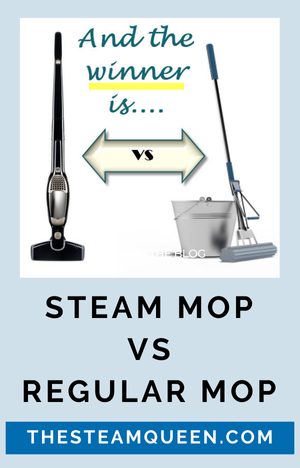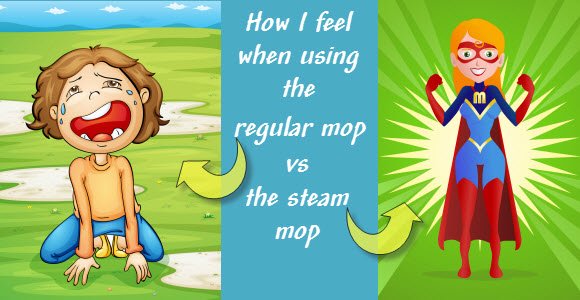Steam Mop vs Regular Mop – Which One Wins?

In a head-to-head steam mop vs regular mop challenge, which do you think would win?
I have my thoughts and they disagree pretty strongly with an article by Consumer Reports.
If you think you’re the last person on the block to make the switch to using an electric mop, you’re not. In a very informal poll of 10 people I know (my parents, siblings, 4 neighbors and myself…) only two of us had a steam mop and one of those only recently went to using one after he saw me use mine.
There were two reasons my little group mentioned for sticking with a traditional or spray mop and those were:
- Type of flooring in their home
- Thought it was more expensive
That first reason has some merit and lets my parents off the hook. They have Pergo floors and the recommended cleaning method tells them to stay away from using steam.
I debunked that second reason in a post I did outlining the costs of the different mop types.
But there are other reasons I think a steam mop is far better and we’ll get to those in a bit.
The Consumer Reports Challenge
In my research for this post, I came across an article describing a steam mop challenge done by Consumer Reports. They compared the two different types and presented their results.
In one paragraph they explained that the steam mop was easier and took less effort but that the “testers found the squeeze mop strangely more satisfying”.
Wait, what?
Who were these people? I can’t think of a single task that wasn’t made easier by some piece of equipment where I said to myself “yeah, this is nice but I feel better about doing it the long, messy way that’s harder on my back”.

There were several other comments in that article that I found funny. First, the test was conducted by overloading the floor with a mass of sticky substances you would be hard pressed to find in even the most run down kitchen of the least cared for burger joint in town.
It’s not surprising they found that a regular mop picked up the layers of gunk better and if you’re the kind of person who is regularly pouring pots of spaghetti sauce on the floor, letting it dry and then hoping to clean it up with a steam mop then you might need something considerably more industrial anyway.
I think a more relevant test would be to show us how both worked under regular conditions – you know, the ones where WE are going to use them – and then compare the two methods.
Another issue that implied the regular mop was better had to do with the assumption that one would not throw the dirty steam mop pads in a load of laundry with their clothes so they’d have to run a separate load just for the small pad – the implication being that would be an inefficient use of water.
I don’t know about you, but I also have towels and kitchen rags that have to be laundered and I’d have no problem putting my mop pads in along with those things. Or hand washing them. Or using the mini cycle on my machine. Anything versus dealing with a regular mop that also has to be cleaned, by the way. To suggest that a steam mop might not be a good choice for this reason is also ignoring how much water is wasted with a traditional mop and bucket approach.
Finally, the article mentioned that replacing a pad in the middle of mopping meant turning the machine upside down which might require that the mop tank be emptied first. What mops were they testing? I haven’t found one yet where you absolutely had to turn the mop upside down to attach the pad nor one where the water would run out of the tank while doing so – they have caps on them!
You have to wonder what the heck mops they were testing and when the article was written. It says it was recently updated in February 2013 but maybe the original article is from the 80s. (That’s not a knock on the 80’s – I’m a huge fan!)
Benefits of a Steam Mop Over a Regular Mop
The challenge they prepared is simply not the typical situation when you’d use a steam mop. I’ve used the regular mop method longer than I should have and having switched would never go back. Never. You can’t make me.
Here are the top benefits I’ve found for going with steam and kicking the bucket (you know what I mean).
Speed
My steam mop gets the job done much faster than the regular mop. Think about the process flow for each method:
Regular Mop and Bucket Process
- Prepare the water and cleaning solution
- Swirl mop in the water
- Scrub a patch of floor
- Rinse the mop in the water
- Wring it out
- (Repeat above 3 steps multiple times for one floor)
- Empty your mop bucket
- Rinse your mop
- Put away your supplies
Steam Mop
- Pull out your steam mop
- Fill water reservoir
- Attach mop pad
- Plug in and wait 30 seconds
- Push the mop around the floor (no scrubbing necessary)
- Unplug mop
- Put mop away
There’s no wringing and rinsing in the middle of the process and the whole deal is much less time consuming.
Amount of Effort
It takes a lot less physical effort to clean floors with a steam mop. It’s as much work as pushing a very light weight vacuum around the floor. It can easily be done with one hand.
Compare that to a regular mop where you need to use both hands in order to apply enough force to get the mop head to remove dirt. Does your back ache like mine when I’m done? I feel like the hunchback of Notre Dame for a good hour.

We have three boys and two are teenagers who share a bathroom and the cleaning of that bathroom. They’re strong boys but it took awhile to get them to understand you couldn’t just swish a regular mop over the floor and expect to get anything accomplished.
The steam mop, on the other hand, is perfect for them because it DOES work by just swishing it around the floor.
The same goes for the whole process of wringing out the mop. You know that the more you can wring out the faster your floors will dry but it takes some work to fully wring out some mops.
My dad has psoriatic arthritis and gripping anything is difficult for him. Mopping the old way would be painful but he could certainly hold the handle for a steam mop in his hand and move that around.
Sanitize
You can’t sanitize your floors with a regular mop unless you use chemicals or heat the water you’re going to use to at least 200 degrees (and keep it at that temperature when it gets applied to your floors).
Most steam mops, on the other hand, can sanitize without chemicals. For those who are sensitive to or have allergies to chemicals a steam mop can make your home more comfortable and less likely to trigger those allergies.
Maybe You Need Both
Thinking back to the Consumer Reports comparison, maybe you need both a steam mop and a regular mop instead of having to choose one vs the other. When your crazy brother comes over and in a sweeping gesture of his arms knocks your pot of spaghetti to the floor, you’ll be ready to pick up the sauce with your regular mop and then get the sticky residue left afterwards with your handy steam mop.

I have to admit, I’m a bit of a steam-mop skeptic.
Most of all, I’m not convinced about the sanitising effect on floors because I’m not convinced the steam reaches the floor at a sanitising temperature that replaces the need for cleaning fluids.
If we talk about a directed jet of steam to clean grout, I get that… no doubt about it. But floor cleaning is a different story: the steam is spread over a wide area of mop, and before it reaches the floor it’s going through the shaggy material and losing most of its pressure. If steam of any sanitising temperature reached the tiles, it would cool instantly on contact. But it’s really not steam that reaches the floor, is it… it’s just water vapour. Hold your hand 1cm above a steaming kettle and you’re going to get severely burned very quickly; but you can keep your hand 30cm above a steaming kettle all day, and it’ll just get wet.
You talk about a temperature of 200 degrees, which I guess with be Farenheit. That’s 93℃. I’d be surprised if it left the steam mop as high as 50℃. I really doubt it’s much hotter than my bucket of water, but that’s easily testable if you have the will.
So how good is a steam mop for removing ‘stuff’ from the floor? Well you conceded in the article that it’s not as good as a regular mop. After steam-mopping the kitchen floor, I was quite surprised how little dirt was on the mop-head, so re-did the floor using my usual cloth-and-bucket-of-hot-water method (with cleaning liquid in the bucket of hot water). At the end, the bucket of water was similarly dirty to the bowl of water I’d washed the steam-cleaner’s mop.
Where the steam cleaner does score, is in ease of use. Albeit that furniture moving effort is the same, it’s much easier on the back than the cloth-and-bucket method. For that reason alone, I bought one for my elderly mother.
I’ve owned a steam mop for a couple of years now. I really like it, although I don’t use it exclusively– I still use my regular mop and bucket with a floor cleaner about once a month or so. I like the smell of the cleaner.
But as far as the “effectiveness” of the steam, or if the temperature is actually as high as it’s supposed to get in order to sanitize– well, I haven’t taken the temperature, but I will give a couple of examples of how clean it can get very dirty floors. On one occasion, I brought it to a friend’s elderly father’s house. He had a couple of dogs and didn’t, shall I say, clean up after them regularly after they had accidents in the house. The pee and poop was totally stuck in the grout of his tile floors, and had been for quite some time. It started coming up immediately with the steam mop, and with very little effort. It did take using 2 mop heads twice each (washing and drying them in-between), but everything came up. Another time, my daughter moved into a rental house where one bedroom had been used as a “cat room” by the previous tenant. Same pee and poop problem as before, with the addition of petrified hairballs and puke on the tile and in the grout. It was horrendous. Used the 2 steam mop heads 4 times each, but the floors came out almost perfectly. Some stuff had completely grown into the grout and could not be removed, but overall, you wouldn’t know what the discoloration was unless you were told. She did not have to pay a cleaning deposit after the landlord saw how clean the room was, and actually gave her one month free, for her (our) trouble. I’d say that’s fairly sanitary.
This made me laugh out loud. “We have three boys and two are teenagers who share a bathroom and the cleaning of that bathroom. They’re strong boys but it took awhile to get them to understand you couldn’t just swish a regular mop over the floor and expect to get anything accomplished.
The steam mop, on the other hand, is perfect for them because it DOES work by just swishing it around the floor.”
I am a mom of a teenager as well who uses the swishing method of cleaning. I live in a small apartment and I think, as I approach my 50’s, a steam mop is the way to go. As for the whole “sanitize” argument, I don’t buy it. I doubt regular mops sanitize any better. When I mop, I feel that after a few dips in the bucket, the mop is full of germs and I am just spreading them, or “swishing” them around the apartment.
Melanie – I think I’m probably right ahead of you on that path to 50 and I wouldn’t go back to a regular mop for anything in the world. I only wish I’d bought one sooner AND had the boys use one! 😉 In fact, when my oldest moved into his apartment he got one of my steam mops.
Here in Arizona hard floors are a big thing so I have tile coming out my ears. When we moved into our current house I didn’t realize just how much time I’d spend mopping.
On sanitizing, you’re right – unless the steam coming out is the right temperature AND you keep the mop in one place for at least 8 seconds (and up to 15 on some mops) then you’re not fully sanitizing. I’ve tried mopping the floor following those timelines and it would take me all day to follow through. Instead, I figure I’m doing at least as good a job as I’d get with a traditional mop and with a heck of a lot less effort. With the right steam mop, you won’t have to exert any pressure on the mop at all to get up regular, every day grime.
Good luck!